The
Home Page Selection
If
you require further information on any
print featured here, please contact
us.
When
a print has been sold it will be marked
as Sold.
A
growing archive of selections
from previous Home pages is featured in
the
Home
Page Selection Archive |
|
See
also :
Click
on a thumbnail (left)
to link directly with the entry for that
print, or scroll down to view all the selected
prints from the current Home
Page.
Images
are not to relative scale (see stated dimensions) and also at only modest resolution.
If you wish to view extracts of an image at higher resolution, please Contact us.
|
|
|
|
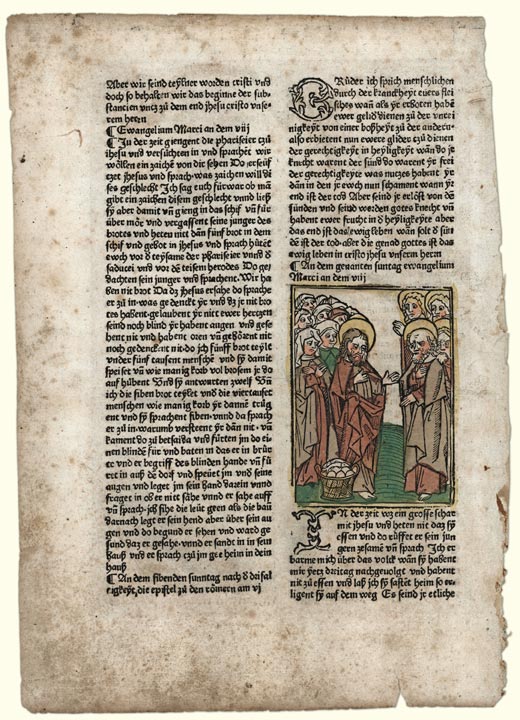
| |
Printer PETER BERGER
Active Augsburg c1486-89
Augsburg was one of the chief centres of early printing
and had produced over 200 illustrated books before 1500.
These typically followed the manuscript tradition, with two columns
and simple outline woodcut illustrations intended to be hand-coloured
in imitation of illuminated manuscripts.
The Miracle of the Loaves and Fishes
295 x 205 mm (sheet); 93 x 78 mm (image)
A page from Spiegel Menschlicher Behälter (Mirror of Human Salvation),
Augsburg edition 1489.
Text and hand-coloured woodcut illustration.
Text only verso.
Watermark: Bull’s head.
A little stained and with small defects at the sheet edges.
£800
Written about 1324, the Mirror of Human Salvation was one of the most
important ‘typological’ texts of the Middle Ages.
Scenes from the Old Testament, or Jewish or secular history, were used
as prophetic symbols of persons or events in the New Testament,
to underline the central doctrines of Christianity.
In the late 15th century in Northern Europe religion and the personal welfare
of the soul remained the predominant motivating force behind artistic creativity.
Christ’s miraculous feeding of a gathering of five thousand
from a basket of five barley loaves and two fish was taken as a ‘type’
of the Eucharist itself.
It also served as an example of mercy and charity – the feeding of the hungry.
Return to top ^ |
|
|
|
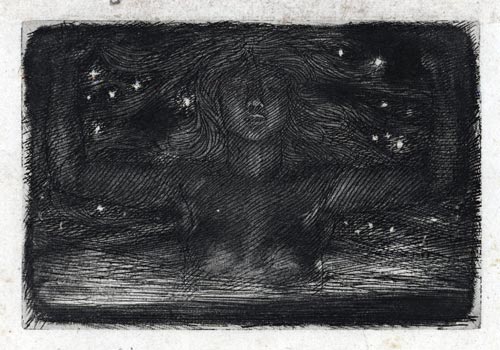 |
|
Sir GEORGE CLAUSEN R.A.
London 1852 – 1944 Cold Ash, Berks
Son of a Danish decorative painter, Clausen studied at South Kensington, in Belgium, Holland and in Paris.
He exhibited paintings at the R.A. from 1876.
Clausen took up etching in 1884, a few years after his marriage and moving to the countryside.
Primarily concerned with landscape and especially life on the land, initially inspired by the French painters Bastien Lepage and Jean François Millet, allegory, as in this rare little mezzotint, Night, is unusual in his œuvre.
Night
Gibson 16
81 x 120 mm
Original etching with rockerwork, c1894.
A pencil signed and dedicated proof
To Mark & Mrs Fisher, with our good wishes for the New Year, George Clausen Dec 30th 94
On japan, with related cockling.
Margins a little stained.
£350
(Clausen painted Mark Fisher R.A.’s portrait in 1900, now in the R.A. collection.)
.
Return to top ^ |
|
|
|
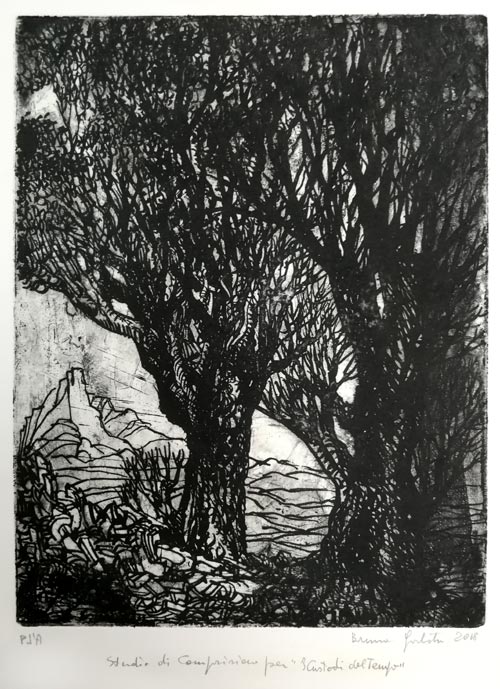 |
|
BRUNO GORLATO A.R.E.
Born Padua 1940
Bruno studied architecture at Venice University and worked in town planning
before devoting himself to painting, etching and teaching.
He has just been elected an Associate of the Royal Society of Painter-Printmakers
and in the catalogue of their recent show RE Original Prints 2019, they describe his work as follows.
Bruno Gorlato’s work depicts imagined spaces, which seem to reference the passing of time and have a sense of history within them. The streets, the long arcades, the dark doorways, the crenelated trees become a theatrical scene. Objects representing humankind’s progress reoccur in the imagery: the castle, the wheel, the boat, the bicycle, each being protagonists and accomplices of the evolution of our civilisation.
Study for I Custodi del Tempo
235 x 180 mm
Original etching, 2018.
Artist’s proof. Signed in pencil, dated, and entitled.
On cream wove paper, with the artist’s blindstamp in the lower margin.
£150
Return
to top ^ |
|
|
|
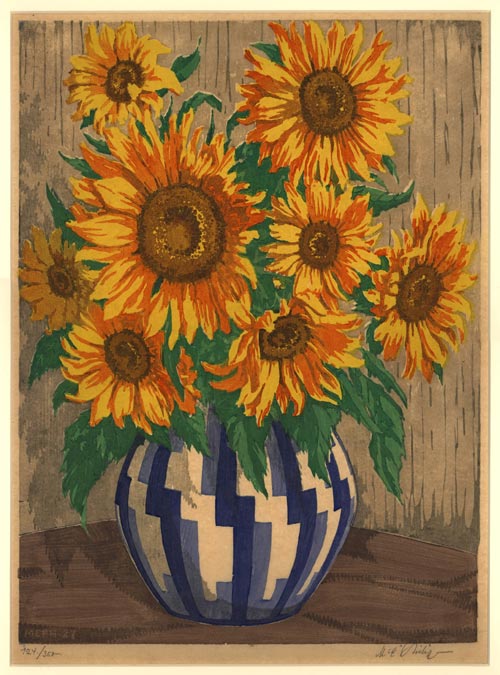 |
|
MARTIN ERICH PHILIPP
Zwickau 1887 – 1973 Dresden
An illustrator and printmaker, Philipp trained at the School of Applied Arts in Dresden
in the early 1900s.
Sommerblumenstrauss in blauem Krug
 Summer Bouquet in a blue Jug Summer Bouquet in a blue Jug
466 x 344 mm
Original colour woodcut, 1927.
The block signed with initials and dated.
Signed in pencil and numbered 124/350.
On japan.
£250
Return
to top ^ |
|
|
|
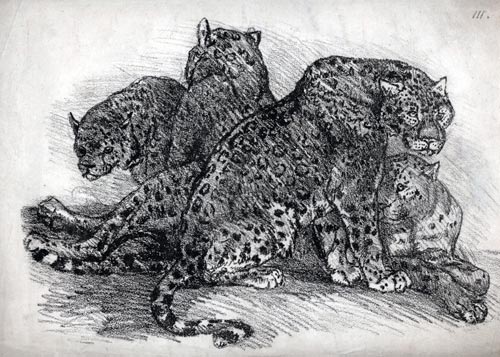 |
|
EDGAR ASHE SPILSBURY
Lambeth 1770 – 1814 Walsall
Spilsbury was a member of the Royal College of Surgeons, 1801-1840
but also painted.
He exhibited between 1800 – 1814. He may have trained with George Stubbs, who was a neighbour and personal friend.
Spilsbury was among those approached by Philip André, whose father had bought Senefelder’s patent, to try the newly invented printmaking process of lithography. Spilsbury produced four lithographic images , published 1803-05 by André & Colnaghi as Studies of Wild Animals from Nature, being impressions from the original designs on stone by Edgar Ashe Spilsbury (though in fact only one of the four designs was original to Spilsbury - and which he signed in the stone with his name, - the other three were based on drawings by George Stubbs (1724-1806) from one of the artist’s sketchbook s in Spilsbury’s collection).
It was while on promotional visit to London in 1800 that Alois Senefelder had perfected chalk lithography; his initial success having been with pen lithography (polyautotypes).
Spilsbury’s must be amongst the very first English chalk lithographs.
Panthers
Lennox Boyd 143 (previously unrecorded)
295 x 415 mm
Chalk lithograph, c1803, after a sketchbook drawing by George Stubbs.
Plate III of the very rare Studies of Wild Animals…
A very good strong impression, on wove paper, trimmed in the margins but the image complete and the plate number present.
Sheet a little
Sold
Return
to top ^ |
|
|
|
|
|
|
|